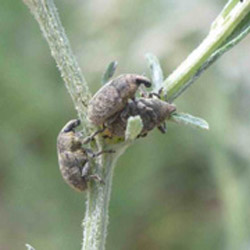UBC researchers weed out ineffective biocontrol agents

Photo of Larinus minutus, a weevil introduced to combat the invasive diffuse knapweed in western North America. The effectiveness of the weevil and other biological agents may be reduced when species combinations work against each other. <br>
Biocontrol programs use an invasive plant’s natural enemies (insects and pathogens) to reduce its population. Most biocontrol programs combine many different enemies – typically about three different species, but sometimes as many as 25 – with the hope that at least one will prove effective.
But more isn’t necessarily better. Some combinations of enemy species can actually end up competing or interfering with each other, instead of attacking the weed.
“It's important to get the right combination of biocontrol agents, as testing species is costly and time-consuming, and no amount of testing can eliminate the risk that something unexpected will occur with the introduction of a new species,” says Andrea Stephens, lead author on the paper published in the Proceedings of the Royal Society B this week.
Until now, biocontrol managers have chosen weed enemies to release based on the individual effect of each species in isolation, with little thought to overall combinations.
“Our study suggests that this approach can lead to ineffective biocontrol, because the interactions between the released enemies can reduce the overall effectiveness of biocontrol,” says Diane Srivastava, author on the paper and professor in UBC's Biodiversity Research Centre.
Of the 75 combinations the researchers investigated, about a quarter appeared to have a smaller combined impact than expected. The researchers suggest simple species combination rules could improve the effectiveness of biocontrol programs.
The study recommends avoiding combinations of species that attack the same part of the plant at the same time, as well as assessing the impact of species attacking reproductive structures.
“In most cases damage from different species of insects was independent,” says Judith Myers, Professor Emerita and author on the paper. “But insect species feeding on the seeds of plants tend to compete and so multiple introductions can be detrimental.”
One of the studies researchers analyzed focused on three agents (two species of weevils and a fly) that have been released in western North America to control two species of invasive plants, diffuse and spotted knapweed. The weevils consume the fly larvae, nullifying the effectiveness of the fly.
Link to paper:
http://rspb.royalsocietypublishing.org/content/280/1760/20122756.short?rss=1
Media Contact
More Information:
http://www.ubc.caAll latest news from the category: Ecology, The Environment and Conservation
This complex theme deals primarily with interactions between organisms and the environmental factors that impact them, but to a greater extent between individual inanimate environmental factors.
innovations-report offers informative reports and articles on topics such as climate protection, landscape conservation, ecological systems, wildlife and nature parks and ecosystem efficiency and balance.
Newest articles

A universal framework for spatial biology
SpatialData is a freely accessible tool to unify and integrate data from different omics technologies accounting for spatial information, which can provide holistic insights into health and disease. Biological processes…

How complex biological processes arise
A $20 million grant from the U.S. National Science Foundation (NSF) will support the establishment and operation of the National Synthesis Center for Emergence in the Molecular and Cellular Sciences (NCEMS) at…

Airborne single-photon lidar system achieves high-resolution 3D imaging
Compact, low-power system opens doors for photon-efficient drone and satellite-based environmental monitoring and mapping. Researchers have developed a compact and lightweight single-photon airborne lidar system that can acquire high-resolution 3D…





















